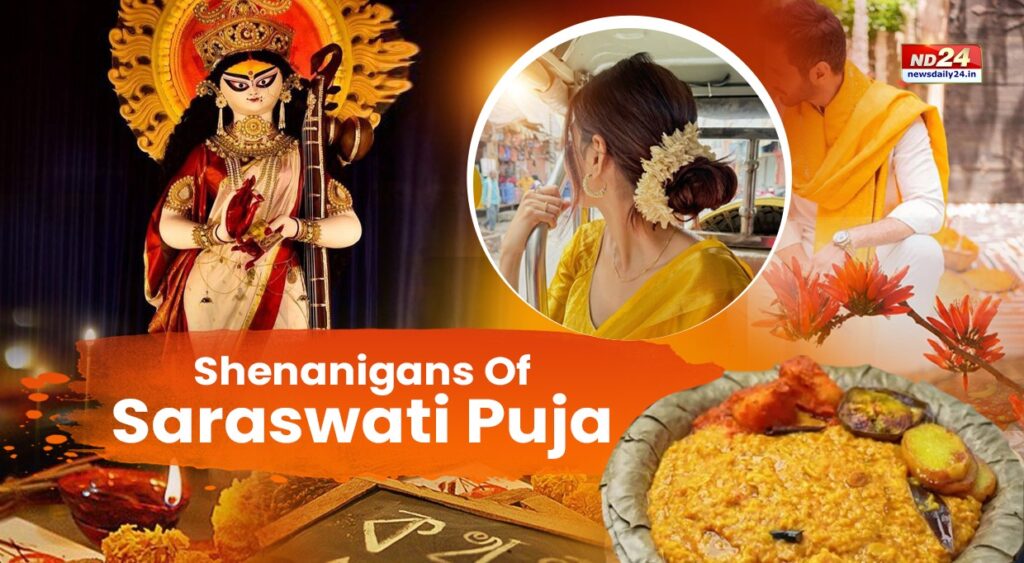Saraswati Puja has always been more than just a religious observance for me; it’s a sensory celebration that fills every corner with tradition, reunions, nostalgia, and a deep sense of community. The air is heavy with the fragrance of freshly picked flowers – gendha, shiuli, calendula, palash, and rajanigandha – blended with the warm scent of incense and dhuno (coconut husk chips). The allure of bhog wafts from every home, and the buzz of excitement builds as the day unfolds, weaving together culture, family, and spirituality.
Looking back at my childhood Saraswati Pujas, I remember helping my mother with the bhog, drawing alpona, and getting dressed for the occasion. The priest’s always-late arrival only added to the excitement. Once the puja began, the festive warmth filled the air, and the real joy came when we dressed up for anjali in yellow or orange sarees, often with a dab of lipstick or perfected hairstyles, trying to look as polished as our mothers.
Newly enrolled children brought their books to the puja, and the priest invited them to write their first letters, seeking Ma Saraswati’s blessings. The highlight, though, was waiting for the freshly ripened jujubes – their sweetness, eaten only after the puja, felt like the best reward. Despite the cold morning struggle, it was all worth it for the magic of the day.
The night before Saraswati Puja in college was a whirlwind of excitement, as we decorated the campus with lights and flowers, staying up late, laughing, and making memories. The next morning, the atmosphere was peaceful, with everyone offering prayers for a successful year ahead. While the sarees were stunning, it was the yellow kurta with aviator sunglasses that stole the show for the men!
If there’s one thing that defines Saraswati Puja for me, it’s the food – the khichuri, labra, tangy topa kuler chutney, and, of course, the ever-necessary payesh. The chutney, with its sour-sweet tang and slimy texture, might be a ‘no-no’ for some, but no Saraswati Puja is complete without it.
Saraswati Puja also carries a romantic charm that feels almost like an unofficial Valentine’s Day. Whether you’re 13 or 31, the day is filled with lightness and possibilities. For the younger ones, it’s about pandal-hopping and sharing mushy, blushy moments with someone special – especially when you twin in your favourite colour. The accidental touches, stolen glances, shared phuchkas, whispered sweet nothings, and aimless wandering together on a crisp winter day create a timeless love story, one that stays in your heart for years.
Today, Saraswati Puja is a special time to reconnect with old friends and cherish the bonds that have stood the test of time. Catching up with friends and teachers, and reminiscing while relishing a plate of warm khichdi in your old school or college canteen, is a feeling like no other. It’s a beautiful moment where time seems to stand still, allowing you to savour both the memories and the food.
In essence, Saraswati Puja is not just a festival – it’s a celebration of life, culture, and the bonds that tie us together. It’s a day to honour the past, relish the present, and create new memories to cherish for years to come. It’s a reminder of where we come from, of the people who shape our lives, and of the traditions that connect us all. Every year, it’s a moment to reconnect with our roots – a reminder of who we were and who we are today.







